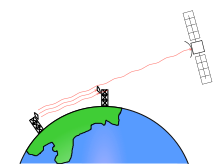Aquacade (satellite)


Aquacade, previously designated Rhyolite, was a class of SIGINT spy satellites operated by the National Reconnaissance Office for the United States Central Intelligence Agency. The National Security Agency (NSA) was also reportedly involved.[1] The program, also known by SIGAD AFP-720 and SIGAD AFP-472, respectively,[2] is still classified. During the same period, the Canyon SIGINT satellites were in use with an apparently somewhat different set of capabilities.
History
The name of the program, originally "Rhyolite", was changed to "Aquacade" in 1975 following the disclosure of the codeword "Rhyolite" in the trial of Christopher Boyce and Andrew Lee.
The Rhyolite/Aquacade satellites, made by TRW, are rumored to have an umbrella-like reflecting dish 20 meters in diameter. They were succeeded by the Magnum/Orion and Mentor series of satellites.
Satellites
During the Cold War, the US intelligence agencies, such as the National Security Agency (NSA), were reportedly able to intercept Soviet microwave traffic using satellites such as Rhyolite/Aquacade.[3] Much of the beam of a microwave link passes the receiving antenna and radiates toward the horizon, into space. By positioning a geosynchronous satellite in the path of the beam, the microwave beam can be received.
It is believed that at least four Rhyolite/Aquacade satellites were launched from Cape Canaveral between June 1970 and April 1978 on Atlas-Agena D launch vehicles, all of which sported distinctive elongated payload shrouds (presumably to house the satellite's large parabolic antenna). Secrecy around the program was tight and the initial Rhyolite mission in 1970 was the first space launch at Cape Canaveral in seven years that reporters were not invited to cover. These were among the final Atlas-Agena launches as well as the last use of LC-13 at CCAS. The satellites had a mass of approximately 700 kg and operated in near-geosynchronous orbits over the Middle East. Signals were relayed to a remote NSA Earth station in Australia, Pine Gap, out of range of Soviet detection. From there, they would be encrypted and sent via another satellite to the NSA's headquarters at Fort Meade for analysis.[4]
| Name | COSPAR ID SATCAT № |
Launch date (UTC) |
Launch vehicle | Launch site | Longitude | Remarks |
|---|---|---|---|---|---|---|
| OPS 5346 | 1970-046A 04418 |
19 June 1970 11:37 |
Atlas SLV-3A Agena-D | CCAFS LC-13 | ||
| OPS 6063 | 1973-013A 06380 |
6 March 1973 09:30 |
Atlas SLV-3A Agena-D | CCAFS LC-13 | ||
| OPS 4258 | 1977-114A 10508 |
11 December 1977 22:45:01 |
Atlas SLV-3A Agena-D | CCAFS LC-13 | ||
| OPS 8790 | 1978-038A 10787 |
7 April 1978 00:45:01 |
Atlas SLV-3A Agena-D | CCAFS LC-13 |
The Canyon Satellite Program was a contemporaneous, near-geosynchronous program with closer ties to the United States Air Force.
References
- ^ James Bamford, The Shadow Factory, 2008, Doubleday, p 176
- ^ Jonathan's Space Report No. 509 Archived 2016-03-03 at the Wayback Machine (2003-09-18)
- ^ Bamford, James (2008). The Shadow Factory. Doubleday. p. 176. ISBN 978-0-385-52132-1.
- ^ "Rhyolite". www.astronautix.com. Encyclopedia Astronautica. Archived from the original on December 28, 2016. Retrieved 25 April 2017.
- Richelson, Jeffrey T. ed. U.S. Military Uses of Space, 1945-1991 Vol 1, Guide. National Security Archive. 1991.
- SIGINT overview from Federation of American Scientists
